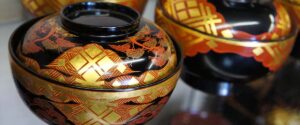
Japan is an island in the Pacific Ocean, located in East Asia. It is the eleventh most populated country in the world, with over 125 million people residing within its borders. With signs of early populations dating back to 30,000 BC, Japan has a rich history, held dear by its citizens who desire to pass their culture down to future generations. The artisans of Japan preserve and promote the traditional arts and crafts that have survived millennia, keeping their ancestors’ memories alive for future generations.

Imari Ware
Imari Ware is the name for brightly colored ceramic pottery made in the Arita area of northwestern Kyushu. Known for its complicated and multi-layered patterns, Imari Ware features underglaze blues, reds, golds, and blacks, with an overglaze of other colors added. Blue and white versions are also available and show the influence of western culture, as it was a popular option for trading with the Dutch East India Trading Company. Today, Imari Ware is still created using the ancient glazing traditions and dense floral designs, making them lovely pieces to add to any collection.
Kimonos
Kimonos are traditional Japanese garments that are the national dress of Japan. They feature a wrapped front with long square sleeves and a rectangular body with a broad sash worn around the waist, called an Obi. There are many different types of kimonos for men, women, and children for various occasions. They are usually worn during summer festivals and special events like graduations, funerals, and weddings. Initially dating back to 300 BC, the kimono became a national constant around the 4th century, during the Hang Dynasty. The motifs that adorn kimonos are influenced by the seasons and nature scenes, especially cherry blossoms. With their silky fabrics and recognizable silhouette, the kimono is Japan personified.

Kamakura-Bori
Kamakura-Bori is lacquerware made in the city of Kamakura. Dating back to 1185, the tradition of using heavily lacquered wooden wares quickly became popular among the Japanese people. They began adorning the pieces with traditional patterns. Although initially a Chinese craft, Kamakura-Bori was quickly adopted by the Japanese and embraced as a traditional craft of their own. The artisans of Japan continue to make lacquerware goods that include paperweights, plates, and trays. During the crafting process, chisel marks are intentionally left on the surface to accentuate the patterned areas, with ink sprinkled along the top to make the patterns stand out. Although the techniques for creating each work of art have evolved, the heart behind the craft continues to hold firm.

The artisans of Japan effortlessly combine traditional elements with modern features, creating unique and beautiful products. You can discover treasures from coast to coast, with a history dating back generations that is kept alive by expert craftsmen who hold the country’s history close to their hearts. At Tuzmo, we strive to bring you world-class souvenirs, pairing you with local artisans who create one-of-a-kind works of art that will last a lifetime.